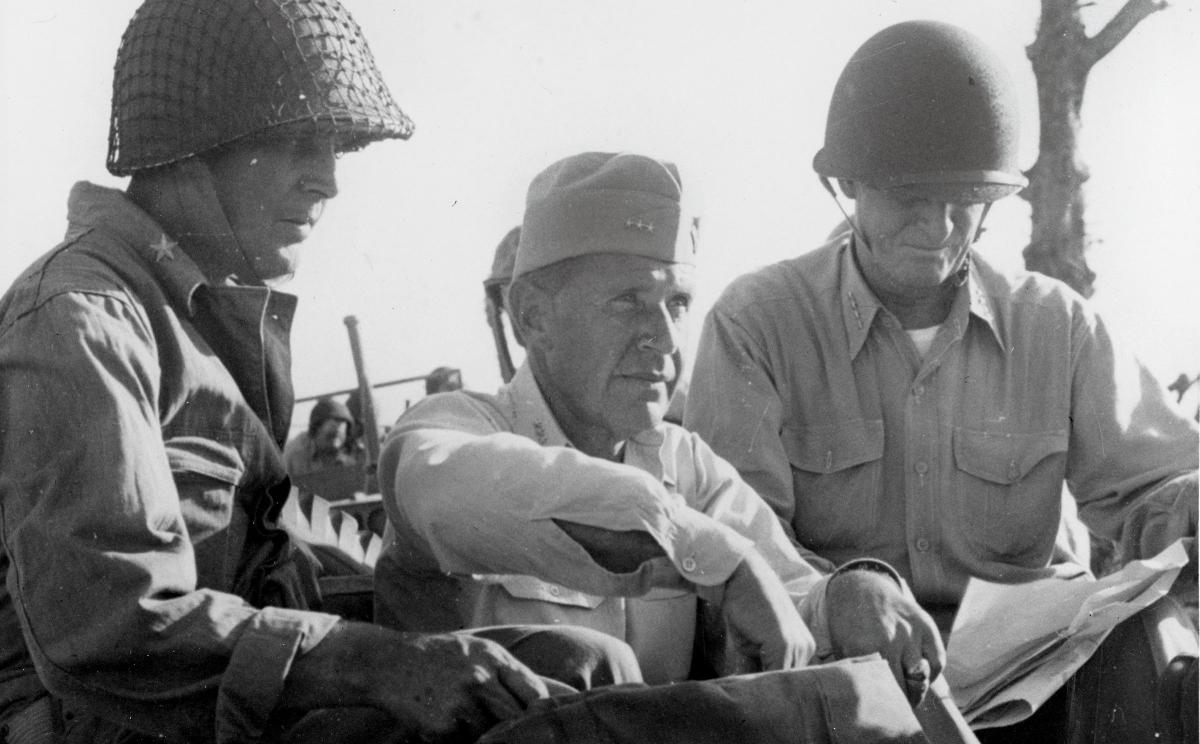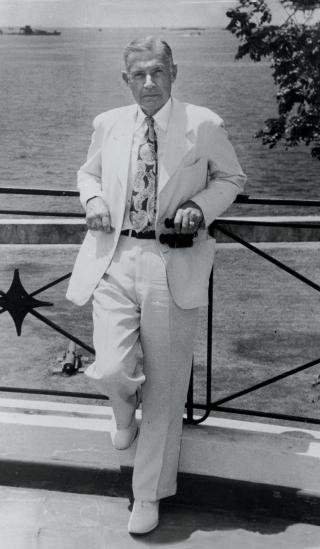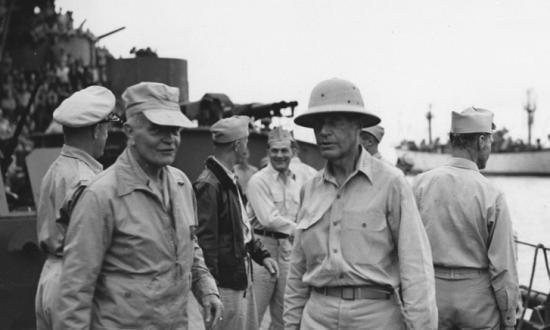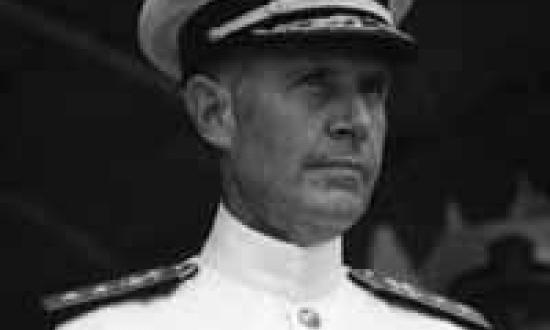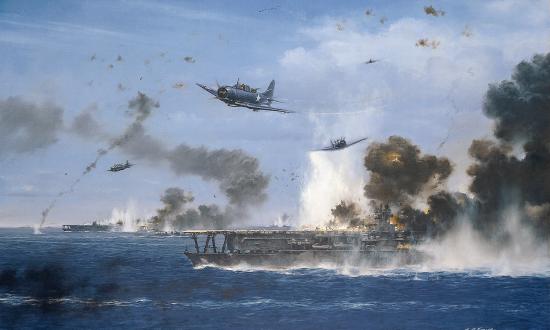Admiral Raymond Spruance was one of the most consequential uniformed Americans during World War II. He was victorious at Midway, a crucial turning point in the Pacific. He commanded the largest fleet in history. Later in life, his country used his talents in high diplomatic office.
Despite these accomplishments, Spruance was not accorded the military rank commensurate with his service. He retired with the rank of four-star admiral. Congress should fix that mistake by passing legislation promoting him posthumously to the rank of five-star fleet admiral.
Background
On 7 December 1941, there were only four Navy billets authorized for four-star rank: the Chief of Naval Operations and the Commanders in Chief of the Pacific, Atlantic, and Asiatic Fleets.1 Pearl Harbor changed that. Over the next four years, the number of American four-star admirals and generals—who had reached terminal rank in their respective services—increased, and they found themselves frequently interacting with their British and Soviet counterparts. To the irritation of the American brass, they were regularly outranked by the five-stars of the British or Soviet field marshals, air marshals, or admirals of the fleet. In addition to causing protocol problems, it implied to some that U.S. military leadership or forces were somehow inferior to their allied counterparts.2
In response, on 14 December 1944, Congress passed legislation creating the five-star ranks of “Fleet Admiral” and “General of the Army.”3 Congress authorized four positions of five-star rank in both the Army and Navy, leaving President Franklin Roosevelt to decide who would be promoted.
Who would receive the promotions was unclear. The choices were driven by seniority, battlefield accomplishments, wartime exigencies, and political considerations. Roosevelt quickly dispensed with the first six appointments. The first went to his trusted chief of staff, Admiral William Leahy, and the second and third to Army Chief of Staff General George C. Marshall and Chief of Naval Operations Admiral Ernest King. The fourth went to General Douglas MacArthur and the fifth to Admiral Chester Nimitz. The sixth went to General Dwight Eisenhower. Army Air Forces Chief of Staff General Henry “Hap” Arnold later received the final Army five-star rank.4
Who would receive the final set of Navy stars, however, was not so easily decided. The choice came down to Admiral William “Bull” Halsey and Admiral Raymond Spruance. Admiral King was asked to draft a recommendation. King was inclined to recommend Spruance, but Halsey received support from influential Georgia Congressman Carl Vinson.5 Halsey got the nod.
The Debate
Should Spruance have received the final Navy five-star promotion instead of Halsey? If the choice were binary, Halsey likely was the correct recipient. In a service that reveres seniority, Halsey was senior. With closely matched options, that may have been determinative in King’s recommendation.
In addition, Halsey’s battlefield accomplishments were significant, including the famous Doolittle Raid that provided an urgently needed tonic for a shell-shocked nation in 1942. Finally, in a war that was fought on the home front as well as on the battlefront, Halsey was a ready and colorful source of anecdotes and quotes for the media.
By contrast, Spruance was junior to Halsey and famously reluctant to hold press conferences.6 In his favor, however, he was recognized among his contemporaries as brilliant, and Admiral King noted in his memorandum that “as to brains . . . [Spruance was] the best man in every way.”7 Moreover, Spruance had commanded U.S. forces in victories at Midway and the Battle of the Philippine Sea. In short, although possessing a record of accomplishments comparable to Halsey, Spruance was the junior.
Spruance himself argued against the notion that he should have received five-star rank in lieu of Halsey: “So far as my getting five star rank is concerned, if I could have had it along with Bill Halsey, that would have been fine; but, if I had received it instead of Bill Halsey, I would have been very unhappy over it.”8
The question, then, is not whether Spruance should have been promoted instead of Halsey, but whether he deserved promotion on his own merits, either at the time or later.
In Support of Promotion
Multiple factors support congressional action to posthumously promote Spruance to fleet admiral. In 2001, then-Congressman Mike Pence introduced H.R. 2492 authorizing the President to “advance the late Admiral Raymond Ames Spruance to the grade of Fleet Admiral of the United States Navy.”9 Although H.R. 2492 did not advance, Spruance should be promoted, given his service record, political and diplomatic acumen, support from Congress and his peers, and interservice parity.
Service Record
Spruance’s service record is comparable to other recipients of five-star rank. His victory at Midway was the turning point in the war in the Pacific.10 In addition, during his later command of Fifth Fleet, he led the campaigns for the Gilberts, Marshalls, the Marianas, Iwo Jima, and Okinawa. As noted by Spruance biographer Tom Buell, “The invasion of Okinawa was equivalent in magnitude to the invasion of Normandy. Raymond Spruance commanded 1,500 ships, the largest and most powerful fleet in history.”11 With this record, Spruance is in the top ranks of U.S. military greats.
Moreover, Spruance led the massive Fifth Fleet armada from the front, which nearly cost him dearly. On 12 May 1945, his flagship, the USS New Mexico (BB-40), was struck by a kamikaze and severely damaged. Spruance narrowly missed injury or death. His staff could not find him for several harrowing minutes, but they finally located him—operating a fire hose.12
Political and Diplomatic Acumen
Spruance’s military record is superb, but it is complemented by a strong record of political and diplomatic accomplishments. During his leadership of Fifth Fleet, he commanded significant Royal Navy forces in combat, earning accolades from both sides of the Atlantic.13 Moreover, following World War II, the United States again used his talents by appointing him ambassador to the Philippines, an action reminiscent of Leahy’s service as ambassador to Vichy France and MacArthur’s service in postwar Japan. This further illustrates Spruance’s reputation for diplomatic prowess, particularly with the postwar Philippines serving on the front lines of the nascent Cold War. His appointment was a tangible sign of Washington’s commitment to the Philippines and the region.
Congressional and Peer Support
Spruance’s wartime and diplomatic record was recognized in his own time as exceptional. Indeed, in seeming acknowledgment that four-star rank failed to fully recognize his accomplishments, Congress authorized Spruance full pay for life as a four-star admiral. By contrast, all other Navy officers received reduced pay upon retirement.14
This exceptional display of congressional support mirrored the support Spruance received from his peers. Throughout the 1950s, Nimitz acted tirelessly to secure promotion for Spruance.15 Although ultimately unsuccessful, the fact that his contemporaries, including Nimitz, recognized he belonged in their exclusive company and took active steps to pursue that end may be one of the greatest indicators that Spruance merited five-star rank.
Interservice Parity
Congress created an equal number of Navy and Army five-star billets in 1944. This careful balancing was upset in 1950, with the promotion of Omar Bradley to General of the Army. Congress could have acted then to promote Spruance, thereby preserving interservice parity, but, at the time, the Navy was at a nadir of popularity. Mired in the infamous “revolt of the admirals,” the Navy was in decidedly bad odor with Congress and the Secretary of Defense. Congress was in no mood to reward the Navy, and, ever since, the Army has maintained a slim 5–4 majority in five-star officers.
Righting a Wrong
Numerous reasons supported promotion of Spruance to fleet admiral in 1945, 1950, or 2001. Having failed to do so, however, Congress should promote him posthumously in 2021. This might be the last, best opportunity to do so while some of the sailors who served under him are still alive. It would right a historic wrong and recognize what Admiral Spruance’s contemporaries already knew: He merits a fifth star.
1. Walter R. Borneman, The Admirals (Boston: Little, Brown and Company, 2012), 412–13.
2. Borneman, The Admirals, 412.
3. Pub. L. No. 78-482.
4. General Arnold would later receive the U.S. Air Force’s only five-star rank of General of the Air Force, making him the only individual in the U.S. military to reach five-star rank in two services. Borneman, The Admirals, 414.
5. Borneman, The Admirals, 415.
6. Thomas B. Buell, The Quiet Warrior (Annapolis, MD: Naval Institute Press, 2009), 210–12.
7. Borneman, The Admirals, 472.
8. Borneman, 472.
9. H.R. Res. 2492, 107th Congress (2001).
10. Importantly, Spruance never minimized the role played by Admiral Jack Fletcher at Midway and shied away from being ascribed the “victor” of Midway.
11. Buell, The Quiet Warrior, 371.
12. Buell, 388.
13. Buell, 350–51, 386–87.
14. Buell, 472.
15. Borneman, The Admirals, 417.



